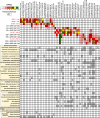The microbiome of the Black Sea water column analyzed by shotgun and genome centric metagenomics
- PMID: 33902743
- PMCID: PMC8067304
- DOI: 10.1186/s40793-021-00374-1
The microbiome of the Black Sea water column analyzed by shotgun and genome centric metagenomics
Abstract
Background: The Black Sea is the largest brackish water body in the world, although it is connected to the Mediterranean Sea and presents an upper water layer similar to some regions of the former, albeit with lower salinity and temperature. Despite its well-known hydrology and physicochemical features, this enormous water mass remains poorly studied at the microbial genomics level.
Results: We have sampled its different water masses and analyzed the microbiome by shotgun and genome-resolved metagenomics, generating a large number of metagenome-assembled genomes (MAGs) from them. We found various similarities with previously described Black Sea metagenomic datasets, that show remarkable stability in its microbiome. Our datasets are also comparable to other marine anoxic water columns like the Cariaco Basin. The oxic zone resembles to standard marine (e.g. Mediterranean) photic zones, with Cyanobacteria (Synechococcus but a conspicuously absent Prochlorococcus), and photoheterotrophs domination (largely again with marine relatives). The chemocline presents very different characteristics from the oxic surface with many examples of chemolithotrophic metabolism (Thioglobus) and facultatively anaerobic microbes. The euxinic anaerobic zone presents, as expected, features in common with the bottom of meromictic lakes with a massive dominance of sulfate reduction as energy-generating metabolism, a few (but detectable) methanogenesis marker genes, and a large number of "dark matter" streamlined genomes of largely unpredictable ecology.
Conclusions: The Black Sea oxic zone presents many similarities to the global ocean while the redoxcline and euxinic water masses have similarities to other similar aquatic environments of marine (Cariaco Basin or other Black Sea regions) or freshwater (meromictic monimolimnion strata) origin. The MAG collection represents very well the different types of metabolisms expected in this kind of environment. We are adding critical information about this unique and important ecosystem and its microbiome.
Keywords: Black Sea microbiota; Euxinic waters; Genome-resolved metagenomics; Redoxcline.
Conflict of interest statement
The author(s) declare no competing interest.
Figures




Similar articles
-
Genomes of Novel Microbial Lineages Assembled from the Sub-Ice Waters of Lake Baikal.Appl Environ Microbiol. 2017 Dec 15;84(1):e02132-17. doi: 10.1128/AEM.02132-17. Print 2018 Jan 1. Appl Environ Microbiol. 2017. PMID: 29079621 Free PMC article.
-
Genomic evidence for sulfur intermediates as new biogeochemical hubs in a model aquatic microbial ecosystem.Microbiome. 2021 Feb 16;9(1):46. doi: 10.1186/s40168-021-00999-x. Microbiome. 2021. PMID: 33593438 Free PMC article.
-
Redox gradient shapes the abundance and diversity of mercury-methylating microorganisms along the water column of the Black Sea.mSystems. 2023 Aug 31;8(4):e0053723. doi: 10.1128/msystems.00537-23. Epub 2023 Aug 14. mSystems. 2023. PMID: 37578240 Free PMC article.
-
Metagenomic studies of the Red Sea.Gene. 2016 Feb 1;576(2 Pt 1):717-23. doi: 10.1016/j.gene.2015.10.034. Epub 2015 Oct 23. Gene. 2016. PMID: 26526132 Review.
-
Microbial ecology of deep-sea hypersaline anoxic basins.FEMS Microbiol Ecol. 2018 Jul 1;94(7). doi: 10.1093/femsec/fiy085. FEMS Microbiol Ecol. 2018. PMID: 29905791 Review.
Cited by
-
Metagenomic 18S rDNA reads revealed zonation of eukaryotic communities in the Yongle blue hole.Front Microbiol. 2024 Jul 29;15:1420899. doi: 10.3389/fmicb.2024.1420899. eCollection 2024. Front Microbiol. 2024. PMID: 39135873 Free PMC article.
-
Postglacial adaptations enabled colonization and quasi-clonal dispersal of ammonia-oxidizing archaea in modern European large lakes.Sci Adv. 2023 Feb 3;9(5):eadc9392. doi: 10.1126/sciadv.adc9392. Epub 2023 Feb 1. Sci Adv. 2023. PMID: 36724220 Free PMC article.
-
Flotillin-associated rhodopsin (FArhodopsin), a widespread paralog of proteorhodopsin in aquatic bacteria with streamlined genomes.mSystems. 2023 Jun 29;8(3):e0000823. doi: 10.1128/msystems.00008-23. Epub 2023 May 24. mSystems. 2023. PMID: 37222519 Free PMC article.
-
Plasmid-Borne Biosynthetic Gene Clusters within a Permanently Stratified Marine Water Column.Microorganisms. 2024 May 2;12(5):929. doi: 10.3390/microorganisms12050929. Microorganisms. 2024. PMID: 38792759 Free PMC article.
-
Bioprospecting for Novel Bacterial Sources of Hydrolytic Enzymes and Antimicrobials in the Romanian Littoral Zone of the Black Sea.Microorganisms. 2022 Dec 14;10(12):2468. doi: 10.3390/microorganisms10122468. Microorganisms. 2022. PMID: 36557721 Free PMC article.
References
-
- Konovalov SK, Murray JW, Luther GW., III Black Sea biogeochemistry. Oceanography. 2005;18:24–35. doi: 10.5670/oceanog.2005.39. - DOI
-
- Stanev EV, He Y, Staneva J, Yakushev E. Mixing in the black sea detected from the temporal and spatial variability of oxygen and sulfide: Argo float observations and numerical modelling. European Geosciences Union; 2014;
-
- Murray JW, Top Z, Özsoy E. Hydrographic properties and ventilation of the Black Sea. Deep Sea res part a Oceanogr res pap. Elsevier. 1991;38:S663–S689.
-
- Conley DJ, Bjorck S, Bonsdorff E, Carstensen J, Destouni G, Gustafsson BG, et al. Hypoxia-related processes in the Baltic Sea. Environ Sci Technol. ACS Publications. 2009;43:3412–3420. - PubMed
Grants and funding
LinkOut - more resources
Full Text Sources
Other Literature Sources
Research Materials
